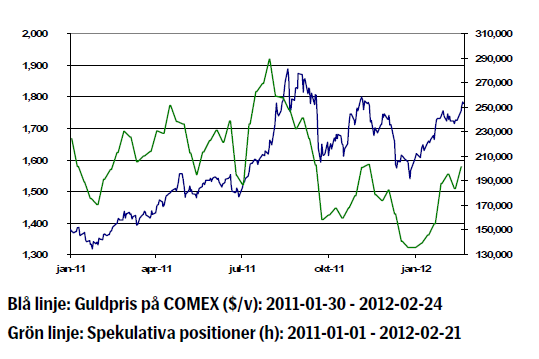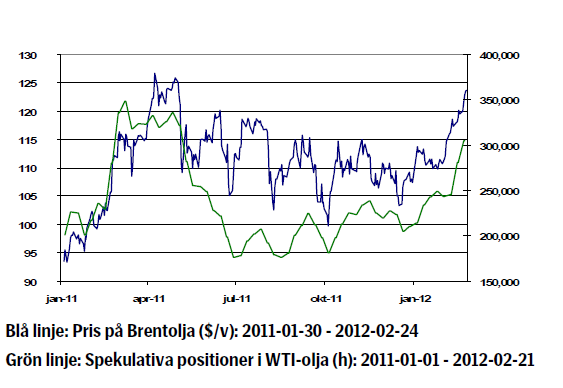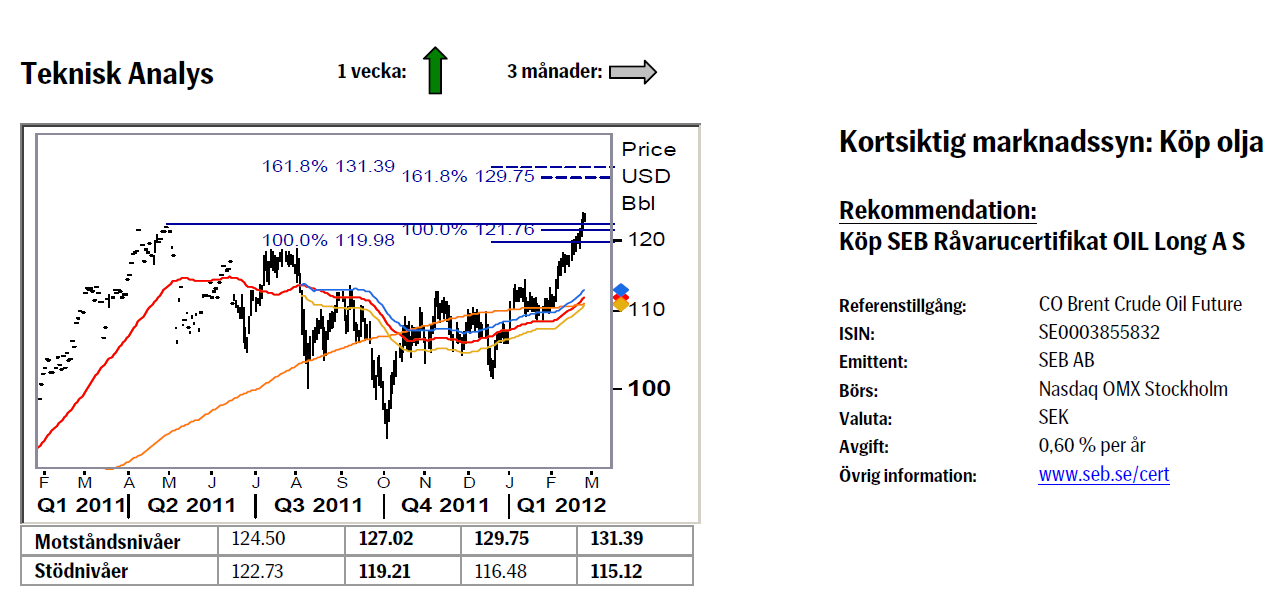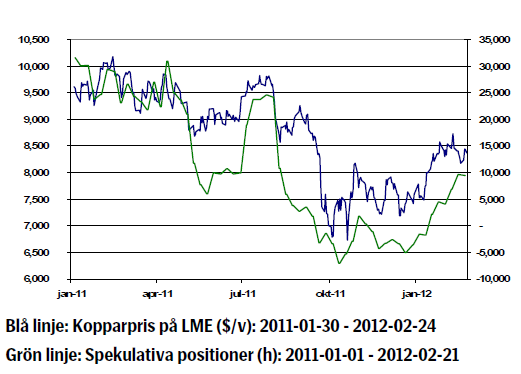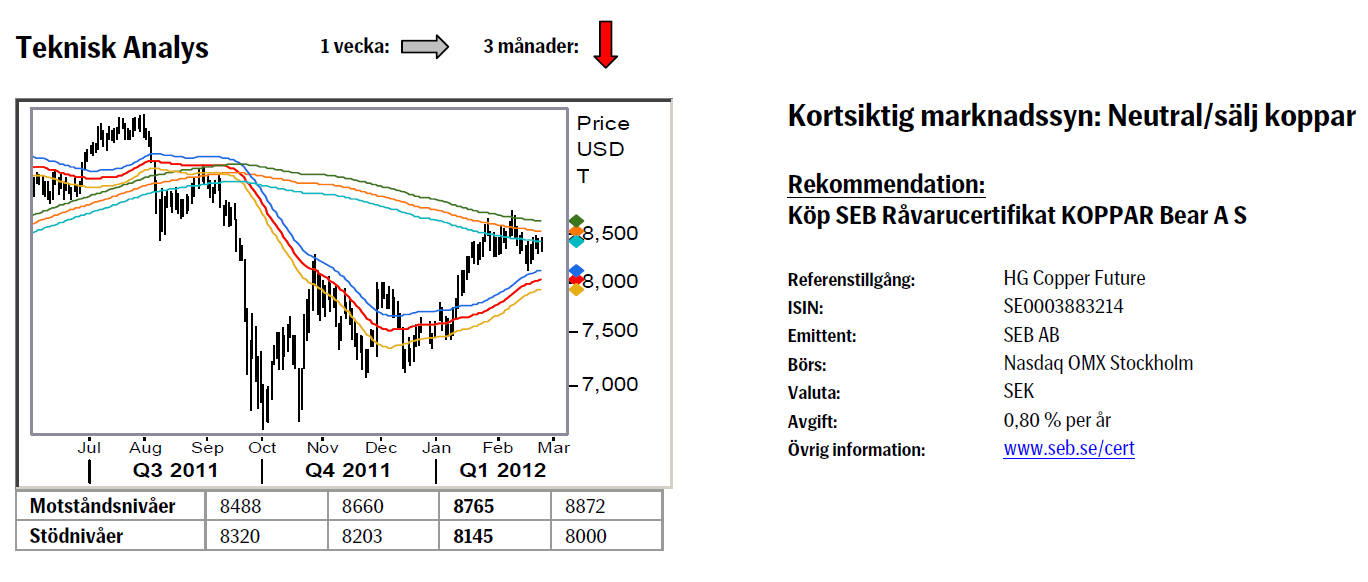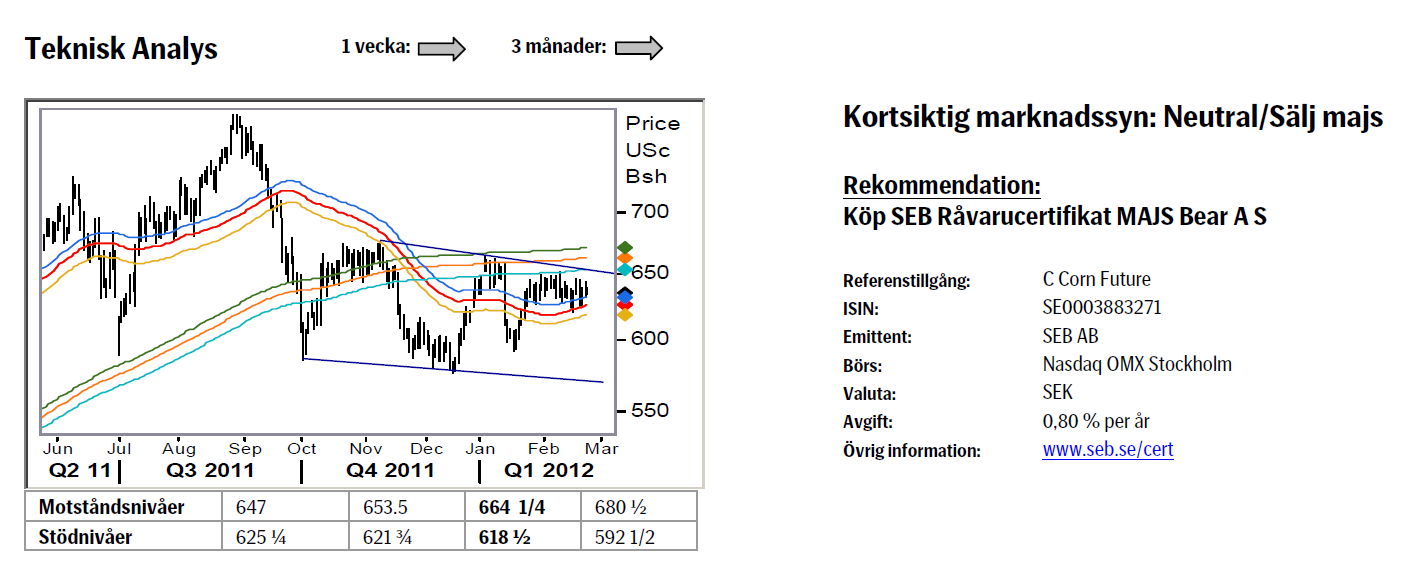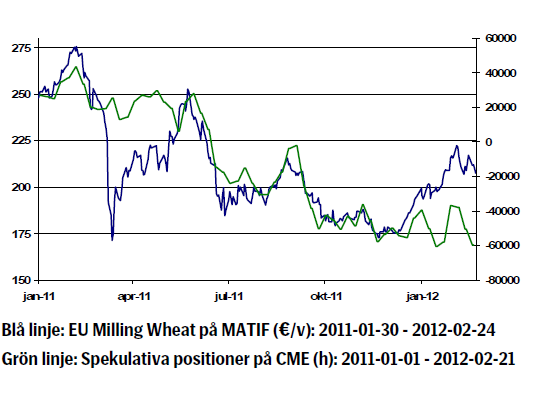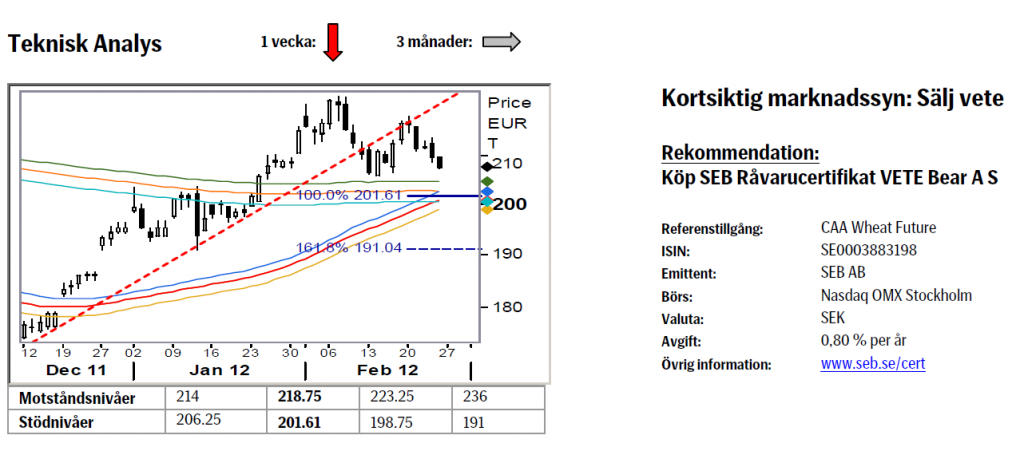Analys
SEB – Råvarukommentarer vecka 9 2012
Sammanfattning: Föregående vecka
 Brett råvaruindex: +2,98 %
Brett råvaruindex: +2,98 %
UBS Bloomberg CMCI TR Index- Energi: +3,47 %
UBS Bloomberg CMCI Energy TR Index - Ädelmetaller: +3,62 %
UBS Bloomberg CMCI Precious Metals TR Index - Industrimetaller: +5,05 %
UBS Bloomberg CMCI Industrial Metals TR Index - Jordbruk: +0,90 %
UBS Bloomberg CMCI Agriculture TR Index
Kortsiktig marknadssyn:
- Guld: Köp
- Olja: Köp
- Koppar: Neutral/sälj
- Majs: Neutral/sälj
- Vete: Sälj
Guld
Guldpriset har stigit på det allmänt positiva marknadssentimentet i råvaror och handlade i veckan på de högsta nivåerna på tre månader. På torsdagen handlade guld till 1.784 dollar per troy uns.
- Alla ratinginstitut för diskussioner kring ytterligare nedgraderingar av Greklands kreditvärdighet vilket skulle kunna liknas vid en default. Grekiska parlamentet måste senast onsdag genomföra en rad besparingsåtgärder för att få utbetalt de stödpaket som lovats. Det är fortfarande osäkert om privata lågivare kommer att acceptera den nedskrivning av utlånat kapital som man förhandlat fram. All osäkerhet kommer att ge stöd åt guldpriset.
- Den fortsatta stimulansen från världens centralbanker ger bränsle åt guldpriset. Bank of England köpte förra veckan obligationer för 50 miljoner pund vilket ökar likviditeten i marknaden och driver på inflationsförväntningarna. I många länder är de reala räntorna, det vill säga marknadsräntan minus inflation, negativa vilket också gör guldinvesteringar attraktiva eftersom alternativkostnaden är låg.
- Efterfrågan på guld från Asien har varit stabilt 2012 och efterfrågan från Indien har ökat sedan novembers och decembers kraftiga nedgångar.
- Teknisk Analys: Marknaden har även denna vecka fortsatt att utveckla sig positivt och vi är nu ytterst nära ett test (och troligt brott) av huvudmotståndet, 1803. Ett lyckat brott dvs. stängning över 1803 är den bekräftelse vi söker för att kunna måtta in nya historiska toppar (som vi ser som mycket sannolika).
Olja
- Oljepriset har skjutit i höjden till följd av den försämrade relationen mellan Iran och Västvärlden och sedan årsskiftet har priset på Brentolja stigit med mer än 10 %. Förra veckan steg priset med 4,5 procent.
- Oroligheterna kring Iran fortsätter. Iran hotar med att landet kommer att agera i förebyggande syfte om ”nationens intressen” hotas av omvärlden. Trots brist på konkreta hot så är varningen ännu ett exempel på den senaste tidens upptrappade konflikt mellan Väst och Iran som i grunden handlar om att det internationella atomenergiorganet IAEA i november presenterade en rapport som antydde att Iran har ett pågående kärnvapenprogram.
- Swift (Society for Worldwide Interbank Financial Telecommunications) hotar med att stänga ute för betalningar de iranska finansinstitut som är anslutna. Skulle Europas lagstiftning godkänna denna avstängning så kommer Iran helt stängas ute från internationell handel. Den iranska regimen är redan pressad av sanktionerna som påverkar landets befolkning och de har mycket att förlora på en väpnad konflikt och en blockad av Hormuzsundet.
- Osäkerheten är stor den närmsta tiden. Den tekniska bilden talar för att vi på kort sikt kan se ett högre oljepris.
- Teknisk Analys: I och med brottet över aprilkontraktets tidigare topp förstärks uppåt potentialen. Nästa givna mål ska sökas vid 129.75/131.39 området, nästa Fibonacci projektionsområde. Där ovanför återfinns också toppen från 2007, 147.50. Det är dock noterbart att i €uro termer så handlas Brentoljan nu på nya rekordnivåer.
Koppar
- Kopparpriset steg 3,8 procent förra veckan vilket till viss del har sin förklaring i att Kina sänkte bankernas reservkrav förra helgen, ett sätt att stimulera inhemsk ekonomi. De nya kraven trädde i kraft i fredags.
- En stabilisering av affärsklimatet för tillverkningsindustrin indikerar att Kinas ekonomi fortsätter att gå mot en mjuklandning. HSBCs PMI för tillverkningen var i februari 49,7 jämfört med 48,8 i januari. Officiellt inköpschefsindex publiceras den förste mars. Man ska dock komma ihåg att det kinesiska nyåret försämrar tillförlitligheten för den statistik som publiceras i januari och februari. Kinas uppbyggande av kopparlager har mattats av och i Japan är efterfrågan av koppar låg.
- Indonesien som är världens tredje största producent av koppar planerar att införa ett exportförbud av all obearbetat metall fram till 2014 i syfte att stimulera inhemsk förädlingsindustri. Med ett oljepris över 120 dollar/fat dämpas möjligheten till en ekonomisk återhämtning vilket även kommer att dämpa den globala efterfrågan på koppar.
- Kortsiktigt tror vi att risken för ett högre pris dämpas av Greklandsuppgörelsen som fortsätter att oroa marknaden. Att Kinas premiärminister förväntas signalera ett tillväxtmål under 8 procent för 2012 på partikongressen den 5:e mars verkar också dämpande på kopparpriset.
- Teknisk Analys: Efter det första ”benet” ned från 233 dagars bandet befinner vi nu oss i vad vi anser vara en korrektion på nedgången. Följaktligen söker vi ett nytt säljläge under kommande vecka(or) och allra helst finner vi det under 8660.
Majs
- The International Grains Council (IGC) gick i torsdags ut med sin senaste prognos avseende det globala utbudet av spannmål, där man justerade upp utbudsestimatet för majs med 0,3 procent jämfört med den senaste rapporten.
- Under de senaste månaderna har det spekulerats mycket kring den påverkan Kinas ökade importbehov av majs kan få på majspriset, detta särskilt då de två senaste årens la Niña-relaterade produktionsproblem fått de globala lagernivåerna att falla ned till rekordlåga nivåer. Så sent som i fredags kom det ut nya indikationer om ökade kinesiska importer från USA, vilket, tillsammans med de nya handelsavtalen mellan Kina och Argentina, stärker denna tes ytterligare. Nyhetsvärdet kan i detta fall ge visst stöd åt majspriset denna vecka.
- I torsdags och fredags höll USDA sitt årliga Agricultural Outlook Forum i Arlington (Virginia), vilket brukar innebära startskottet för de mer detaljerade prognoserna avseende det amerikanska spannmålsutbudet för det kommande skördeåret. Enligt vår bedömning var det inga större utropstecken, den kommande amerikanska skörden av majs ser fortfarande god ut. Därmed bör marknadens ögon under de kommande veckorna riktas in mot Brasilien och Ukraina igen.
- Det är i nuläget svårt att fundamentalt ge några starka argument för att majspriset kortsiktigt ska lämna nuvarande prisnivåer.
- Teknisk Analys: Marknaden har fortsatt att handla mellan 55 & 233 dagars medelvärdesband och befinner sig följaktligen fortsatt inklämd i det neutrala området.
Vete
- Under förra veckan kunde vi verkligen se hur proppen gick ur marknaden, detta från en för oss omotiverat hög prisnivå. Totalt sett gick priset i Paris ned med 4,5 procent, men vi är fortfarande av åsikten att det bör fortsätta nedåt mot en nivå under 200 EUR/ton inom kort.
- I sin prognos avseende vetemarknaden justerade IGC i torsdags upp sitt produktionsestimat för innevarande skördeår. De globala vetelagren är redan på historiskt sett rekordhög nivå, där denna typ av bekräftelse ger ytterligare tryck nedåt på vetepriset.
- Diskussionen kring Ukrainas eventuella restriktioner av spannmål fortsätter. Stor osäkerhet råder fortsatt avseende bortfallet av vete i landet efter den senaste tidens köldknäpp runt Svarta havet. Även om landet endast producerar 3-4 procent av vetet i världen anses landet vara en viktig exportör.
- Efter att ha stigit något den senaste månaden har nu andelen spekulativa köpare av vete i Chicago fallit ned mot tidigare bottennivåer igen. Vi väljer att hålla med spekulanterna i terminsmarknaden och ser negativt på priset kommande veckor.
- Teknisk Analys: Brottet under trendlinjen, återtestet och det förnyade fallet stärker oss i vår vy att lägre nivåer ska sökas. Ett viktigt test av 55/233dagars medelvärdesbanden ser ut att kunna komma under nästa vecka. Hur handeln i detta område utvecklar sig kommer att ge en hel del viktig information om den lite större utvecklingen så håll ögonen öppna efter signaler.
[box]SEB Veckobrev Veckans råvarukommentar är producerat av SEB Merchant Banking och publiceras i samarbete och med tillstånd på Råvarumarknaden.se[/box]
Disclaimer
The information in this document has been compiled by SEB Merchant Banking, a division within Skandinaviska Enskilda Banken AB (publ) (“SEB”).
Opinions contained in this report represent the bank’s present opinion only and are subject to change without notice. All information contained in this report has been compiled in good faith from sources believed to be reliable. However, no representation or warranty, expressed or implied, is made with respect to the completeness or accuracy of its contents and the information is not to be relied upon as authoritative. Anyone considering taking actions based upon the content of this document is urged to base his or her investment decisions upon such investigations as he or she deems necessary. This document is being provided as information only, and no specific actions are being solicited as a result of it; to the extent permitted by law, no liability whatsoever is accepted for any direct or consequential loss arising from use of this document or its contents.
About SEB
SEB is a public company incorporated in Stockholm, Sweden, with limited liability. It is a participant at major Nordic and other European Regulated Markets and Multilateral Trading Facilities (as well as some non-European equivalent markets) for trading in financial instruments, such as markets operated by NASDAQ OMX, NYSE Euronext, London Stock Exchange, Deutsche Börse, Swiss Exchanges, Turquoise and Chi-X. SEB is authorized and regulated by Finansinspektionen in Sweden; it is authorized and subject to limited regulation by the Financial Services Authority for the conduct of designated investment business in the UK, and is subject to the provisions of relevant regulators in all other jurisdictions where SEB conducts operations. SEB Merchant Banking. All rights reserved.
Analys
OPEC+ will likely unwind 500 kb/d of voluntary quotas in October. But a full unwind of 1.5 mb/d in one go could be in the cards

Down to mid-60ies as Iraq lifts production while Saudi may be tired of voluntary cut frugality. The Brent December contract dropped 1.6% yesterday to USD 66.03/b. This morning it is down another 0.3% to USD 65.8/b. The drop in the price came on the back of the combined news that Iraq has resumed 190 kb/d of production in Kurdistan with exports through Turkey while OPEC+ delegates send signals that the group will unwind the remaining 1.65 mb/d (less the 137 kb/d in October) of voluntary cuts at a pace of 500 kb/d per month pace.

Signals of accelerated unwind and Iraqi increase may be connected. Russia, Kazakhstan and Iraq were main offenders versus the voluntary quotas they had agreed to follow. Russia had a production ’debt’ (cumulative overproduction versus quota) of close to 90 mb in March this year while Kazakhstan had a ’debt’ of about 60 mb and the same for Iraq. This apparently made Saudi Arabia angry this spring. Why should Saudi Arabia hold back if the other voluntary cutters were just freeriding? Thus the sudden rapid unwinding of voluntary cuts. That is at least one angle of explanations for the accelerated unwinding.
If the offenders with production debts then refrained from lifting production as the voluntary cuts were rapidly unwinded, then they could ’pay back’ their ’debts’ as they would under-produce versus the new and steadily higher quotas.
Forget about Kazakhstan. Its production was just too far above the quotas with no hope that the country would hold back production due to cross-ownership of oil assets by international oil companies. But Russia and Iraq should be able to do it.
Iraqi cumulative overproduction versus quotas could reach 85-90 mb in October. Iraq has however steadily continued to overproduce by 3-5 mb per month. In July its new and gradually higher quota came close to equal with a cumulative overproduction of only 0.6 mb that month. In August again however its production had an overshoot of 100 kb/d or 3.1 mb for the month. Its cumulative production debt had then risen to close to 80 mb. We don’t know for September yet. But looking at October we now know that its production will likely average close to 4.5 mb/d due to the revival of 190 kb/d of production in Kurdistan. Its quota however will only be 4.24 mb/d. Its overproduction in October will thus likely be around 250 kb/d above its quota with its production debt rising another 7-8 mb to a total of close to 90 mb.
Again, why should Saudi Arabia be frugal while Iraq is freeriding. Better to get rid of the voluntary quotas as quickly as possible and then start all over with clean sheets.
Unwinding the remaining 1.513 mb/d in one go in October? If OPEC+ unwinds the remaining 1.513 mb/d of voluntary cuts in one big go in October, then Iraq’s quota will be around 4.4 mb/d for October versus its likely production of close to 4.5 mb/d for the coming month..
OPEC+ should thus unwind the remaining 1.513 mb/d (1.65 – 0.137 mb/d) in one go for October in order for the quota of Iraq to be able to keep track with Iraq’s actual production increase.
October 5 will show how it plays out. But a quota unwind of at least 500 kb/d for Oct seems likely. An overall increase of at least 500 kb/d in the voluntary quota for October looks likely. But it could be the whole 1.513 mb/d in one go. If the increase in the quota is ’only’ 500 kb/d then Iraqi cumulative production will still rise by 5.7 mb to a total of 85 mb in October.
Iraqi production debt versus quotas will likely rise by 5.7 mb in October if OPEC+ only lifts the overall quota by 500 kb/d in October. Here assuming historical production debt did not rise in September. That Iraq lifts its production by 190 kb/d in October to 4.47 mb/d (August level + 190 kb/d) and that OPEC+ unwinds 500 kb/d of the remining quotas in October when they decide on this on 5 October.

Analys
Modest draws, flat demand, and diesel back in focus

U.S. commercial crude inventories posted a marginal draw last week, falling by 0.6 million barrels to 414.8 million barrels. Inventories remain 4% below the five-year seasonal average, but the draw is far smaller than last week’s massive 9.3-million-barrel decline. Higher crude imports (+803,000 bl d WoW) and steady refinery runs (93% utilization) helped keep the crude balance relatively neutral.

Yet another drawdown indicates commercial crude inventories continue to trend below the 2015–2022 seasonal norm (~440 million barrels), though at 414.8 million barrels, levels are now almost exactly in line with both the 2023 and 2024 trajectory, suggesting stable YoY conditions (see page 3 attached).
Gasoline inventories dropped by 1.1 million barrels and are now 2% below the five-year average. The decline was broad-based, with both finished gasoline and blending components falling, indicating lower output and resilient end-user demand as we enter the shoulder season post-summer (see page 6 attached).
On the diesel side, distillate inventories declined by 1.7 million barrels, snapping a two-week streak of strong builds. At 125 million barrels, diesel inventories are once again 8% below the five-year average and trending near the low end of the historical range.
In total, commercial petroleum inventories (excl. SPR) slipped by 0.5 million barrels on the week to ish 1,281.5 million barrels. While essentially flat, this ends a two-week streak of meaningful builds, reflecting a return to a slightly tighter situation.
On the demand side, the DOE’s ‘products supplied’ metric (see page 6 attached), a proxy for implied consumption, softened slightly. Total demand for crude oil over the past four weeks averaged 20.5 million barrels per day, up just 0.9% YoY.
Summing up: This week’s report shows a re-tightening in diesel supply and modest draws across the board, while demand growth is beginning to flatten. Inventories remain structurally low, but the tone is less bullish than in recent weeks.

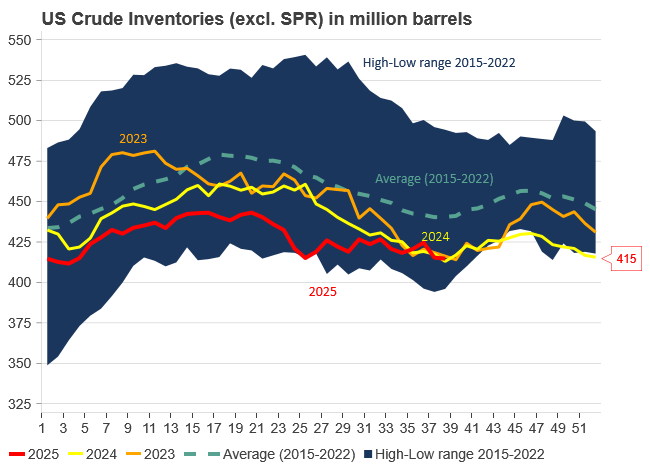
Analys
Are Ukraine’s attacks on Russian energy infrastructure working?

Brent crude rose 1.6% yesterday. After trading in a range of USD 66.1 – 68.09/b it settled at USD 67.63/b. A level which we are well accustomed to see Brent crude flipping around since late August. This morning it is trading 0.5% higher at USD 68/b. The market was expecting an increase of 230 kb/d in Iraqi crude exports from Kurdistan through Turkey to the Cheyhan port but that has so far failed to materialize. This probably helped to drive Brent crude higher yesterday. Indications last evening that US crude oil inventories likely fell 3.8 mb last week (indicative numbers by API) probably also added some strength to Brent crude late in the session. The market continues to await the much heralded global surplus materializing as rising crude and product inventories in OECD countries in general and the US specifically.

The oil market is starting to focus increasingly on the successful Ukrainian attacks on Russian oil infrastructure. Especially the attacks on Russian refineries. Refineries are highly complex and much harder to repair than simple crude oil facilities like export pipelines, ports and hubs. It can take months and months to repair complex refineries. It is thus mainly Russian oil products which will be hurt by this. First oil product exports will go down, thereafter Russia will have to ration oil product consumption domestically. Russian crude exports may not be hurt as much. Its crude exports could actually go up as its capacity to process crude goes down. SEB’s Emerging Market strategist Erik Meyersson wrote about the Ukrainian campaign this morning: ”Are Ukraine’s attacks on Russian energy infrastructure working?”. Phillips P O’Brian published an interesting not on this as well yesterday: ”An Update On The Ukrainian Campaign Against Russian Refineries”. It is a pay-for article, but it is well worth reading. Amongst other things it highlights the strategic focus of Ukraine towards Russia’s energy infrastructure. A Ukrainian on the matter also put out a visual representation of the attacks on twitter. We have not verified the data representation. It needs to be interpreted with caution in terms of magnitude of impact and current outage.
Complex Russian oil refineries are sitting ducks in the new, modern long-range drone war. Ukraine is building a range of new weapons as well according to O’Brian. The problem with attacks on Russian refineries is thus on the rise. This will likely be an escalating problem for Russia. And oil products around the world may rise versus the crude oil price while the crude oil price itself may not rise all that much due to this.
Russian clean oil product exports as presented by SEB’s Erik Meyersson in his note this morning.
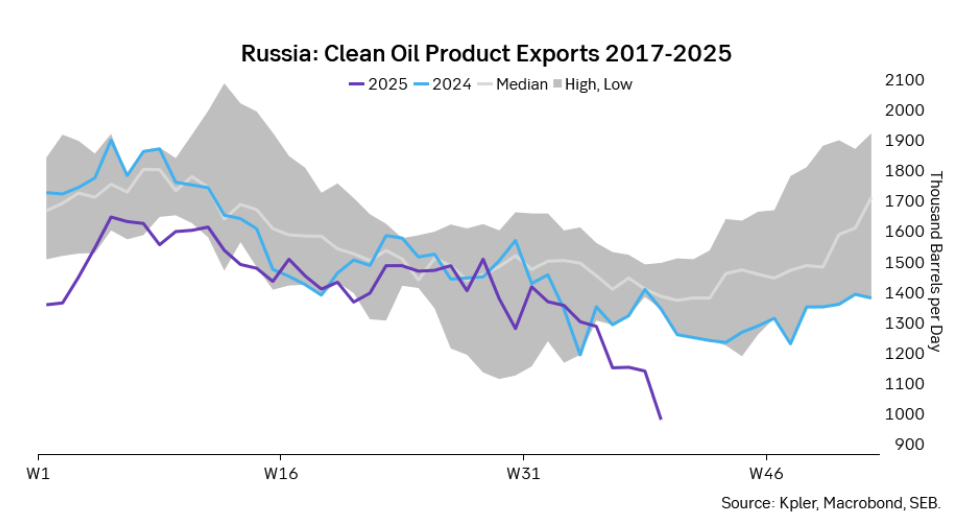
The ICE Gasoil crack and the 3.5% fuel oil crack has been strengthening. The 3.5% crack should have weakened along with rising exports of sour crude from OPEC+, but it hasn’t. Rather it has moved higher instead. The higher cracks could in part be due to the Ukrainian attacks on Russian oil refineries.
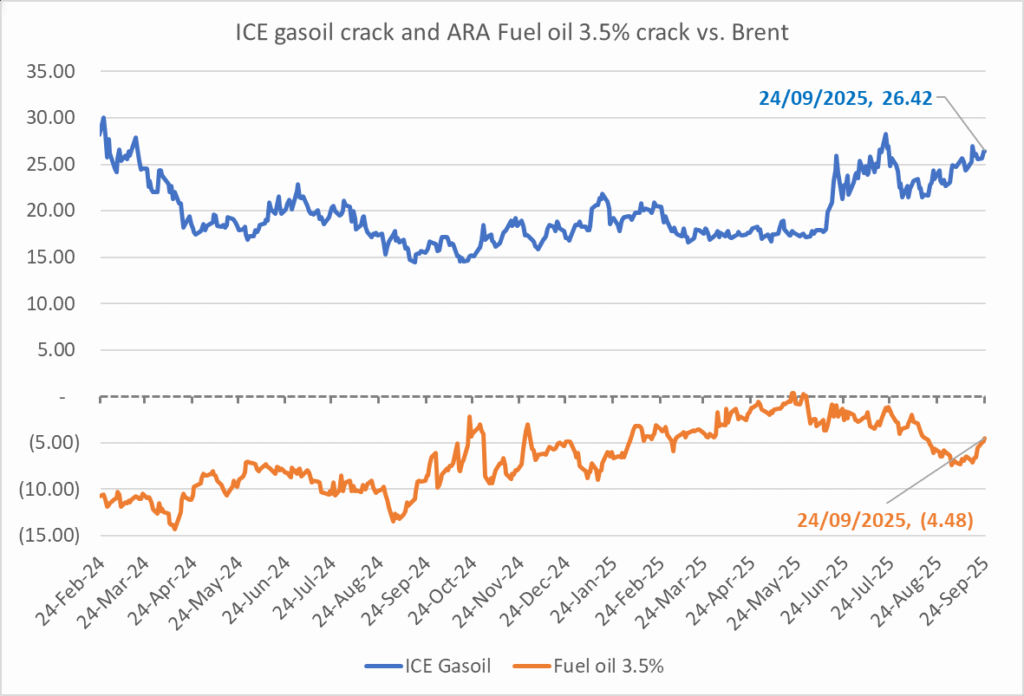
Ukrainian inhabitants graphical representation of Ukrainian attacks on Russian oil refineries on Twitter. Highlighting date of attacks, size of refineries and distance from Ukraine. We have not verified the detailed information. And you cannot derive the amount of outage as a consequence of this.

-

 Nyheter3 veckor sedan
Nyheter3 veckor sedanMahvie Minerals i en guldtrend
-

 Nyheter4 veckor sedan
Nyheter4 veckor sedanEurobattery Minerals satsar på kritiska metaller för Europas självförsörjning
-

 Nyheter4 veckor sedan
Nyheter4 veckor sedanGuldpriset kan närma sig 5000 USD om centralbankens oberoende skadas
-
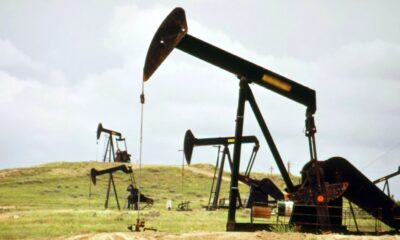
 Nyheter4 veckor sedan
Nyheter4 veckor sedanOPEC signalerar att de inte bryr sig om oljepriset faller kommande månader
-

 Analys3 veckor sedan
Analys3 veckor sedanVolatile but going nowhere. Brent crude circles USD 66 as market weighs surplus vs risk
-

 Nyheter3 veckor sedan
Nyheter3 veckor sedanAktier i guldbolag laggar priset på guld
-

 Nyheter3 veckor sedan
Nyheter3 veckor sedanKinas elproduktion slog nytt rekord i augusti, vilket även kolkraft gjorde
-

 Nyheter2 veckor sedan
Nyheter2 veckor sedanTyskland har så höga elpriser att företag inte har råd att använda elektricitet


